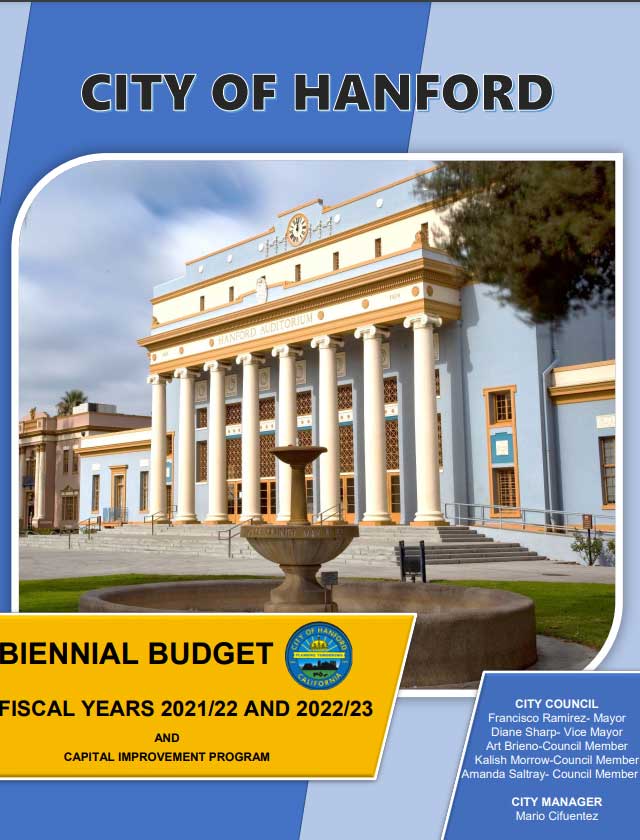The City of Hanford faces several key infrastructure challenges, including maintaining and upgrading its aging transportation infrastructure, addressing stormwater management and flood protection issues, ensuring reliable and sustainable water supply and treatment infrastructure, upgrading public facilities such as parks, community centers, and libraries, and improving access to public transit and other transportation options. Additionally, the city must balance the need for infrastructure improvements with the cost of these projects, while also ensuring that residents and businesses have access to safe and reliable infrastructure services that support economic growth and quality of life in the community.

Sample Highlights from the Capital Improvement Plan
Project ID
Project Title
Project Start Year
Project Description
Project Spend Total
Page Ref
Project Satus
240851
Sand Slough Houston Avenue Pipeline Project
2023
This project will pipe the north end of the existing Sand Slough across Houston Avenue into the southern portion of Sand Slough in order to provide additional capacity of the slough.
151130
241
Ongoing
240879
Manhole Repair and Coating Project
2023
This project provides for repair and coating of damaged sanitary sewer manholes and lift stations where corrosion is affecting concrete surfaces.
202238
249
Ongoing
240884
Wastewater Treatment Plant Expansion Reserve
2023
These funds will be deposited into a separate account to fund the next expansion of the Wastewater Treatment Plan (WWTP).
1615500
250
Ongoing
240888
Soil Cement Sludge Bed Renovation Project
2023
The Wastewater treatment plant has six soil-cement lined sludge beds that were constructed in 2003. This project provides for repair of the sludge beds over a two year period.
303730
251
Ongoing
240920
Water Distribution Main Extension Program
2023
This project includes replacing undersized distribution mains or extending distribution mains in various locations throughout the City to enhance system performance.
2554612
261
Ongoing
Explore all options available to you!
Citylitics offers access to over 30,000 unique locations across North America through our Capital Projects Dashboard (CPD).
Capital Projects Dashboard (CPD) provides a comprehensive market view of all planned infrastructure spend in one single view with powerful filters such as: population, project value, fiscal year, project status, project description, geography, and more. The dashboard will help identify opportunity hot spots, create data-driven forecasts you can be confident in with bottom-up data for the next 5 years of planned infrastructure spend, and uncover true market needs.
How to Read a Capital Improvement Plan (CIP) for Business Development?
When a city, municipality or state issues a Capital Improvement Plan (CIP), it can be overwhelming and daunting, but there are a few key things you need to investigate. Let’s start with the definition of CIP – A Capital Improvement Plan (CIP) contains all the individual capital projects, equipment purchases, and major studies for a local government; in conjunction with construction and completion schedules, and in consort with financing plans. The plan provides a working blueprint for sustaining and improving the community’s infrastructures. It coordinates strategic planning, financial capacity, and physical development. A CIP stands at the epicenter of a government’s Planning, Public Works, and Finance departments. When a CIP is issued, it typically includes the following information:
- A listing of the capital projects or equipment to be purchased
- The projects ranked in order of preference
- The plan for financing the projects
- A timetable for the construction or completion of the project
- Justification for the project
- Explanation of expenses for the project
Now, for business development, while the capital plan is interesting, the capital program is for capital expenditures that extends five to ten years beyond the capital budget. Knowing the difference is important so you can influence upcoming program versus just responding to an RFP. If reading the CIP makes your head explode, or you want to save time, Request a Demo of Citylitics CIP dashboard with over 20,000 CIPs from USA and Canada. Citylitics has 20,000 plus available CIPs, how can we help you? What states, cities or counties are you looking to improvement your business development, we can assist you in influencing an upcoming RFP versus simply responding to an RFP. Citylitics Capital Projects Dataset is a comprehensive resource for businesses and organizations looking to track and analyze planned infrastructure spend in their area. The dataset offers a range of features and benefits, including:
- Comprehensive Market View: The dataset provides a single view of all planned infrastructure spend, with powerful filters such as population, project value, fiscal year, project status, project description, geography, and more. This allows businesses to gain a comprehensive understanding of the market and identify new opportunities.
- Identify Opportunity Hot Spots: The dataset offers map views and filters that allow users to identify opportunity hot spots where they need to allocate resources. This helps businesses to understand where they should focus their efforts to achieve the best results.
- Create Data-Driven Forecasts: The dataset provides bottom-up data for the next 5 years of planned infrastructure spend, allowing businesses to create data-driven forecasts they can be confident in.
- Uncover True Market Needs: The dataset allows businesses to develop long-term business plans, R&D, and growth initiatives based on true, bottom-up market needs instead of opinions and anecdotes. This helps businesses to make more informed decisions and achieve better results.
With Citylitics Capital Projects Dataset, businesses can gain a deeper understanding of planned infrastructure spend in their area, which can help them to identify new opportunities and make more informed decisions.
